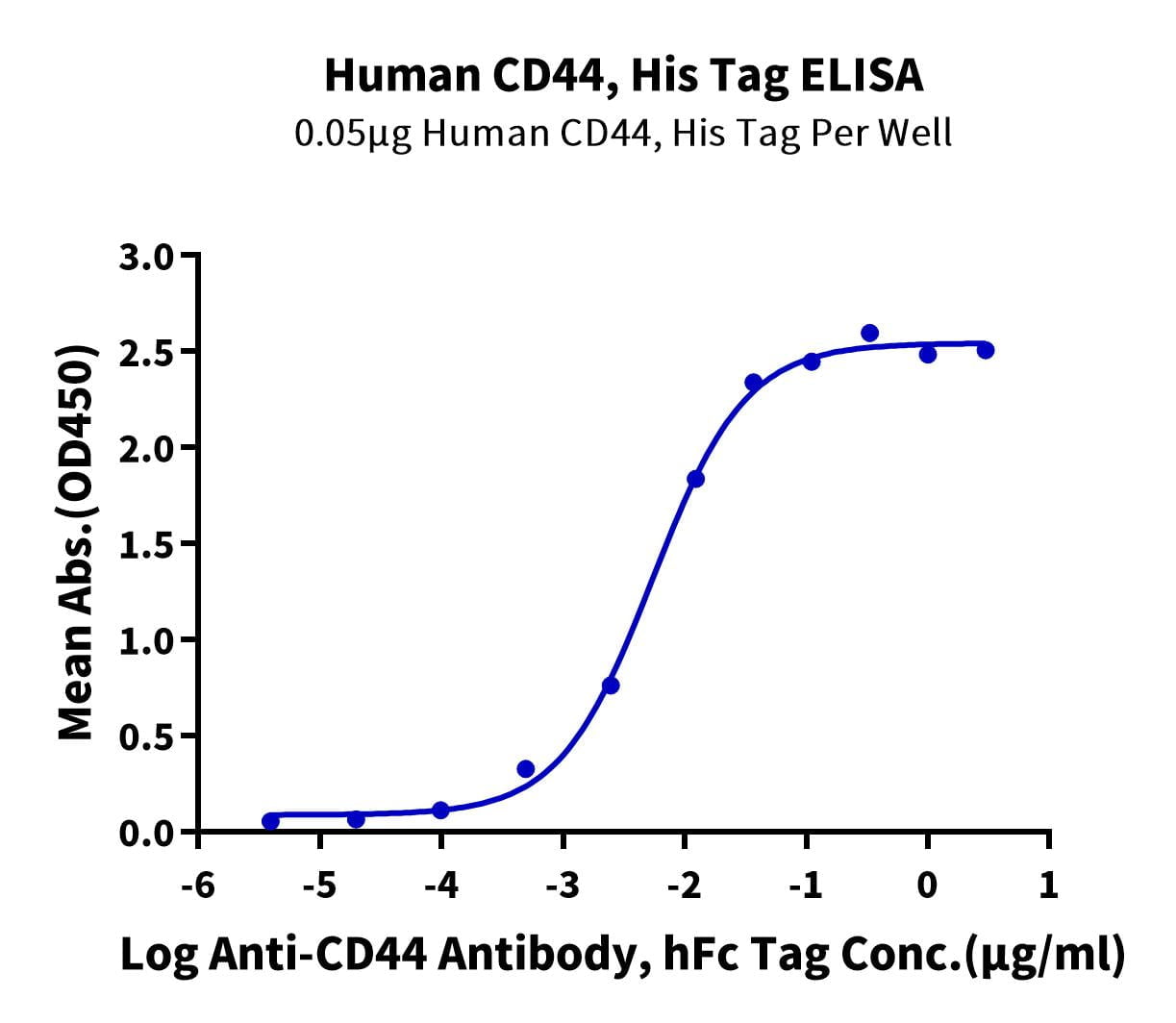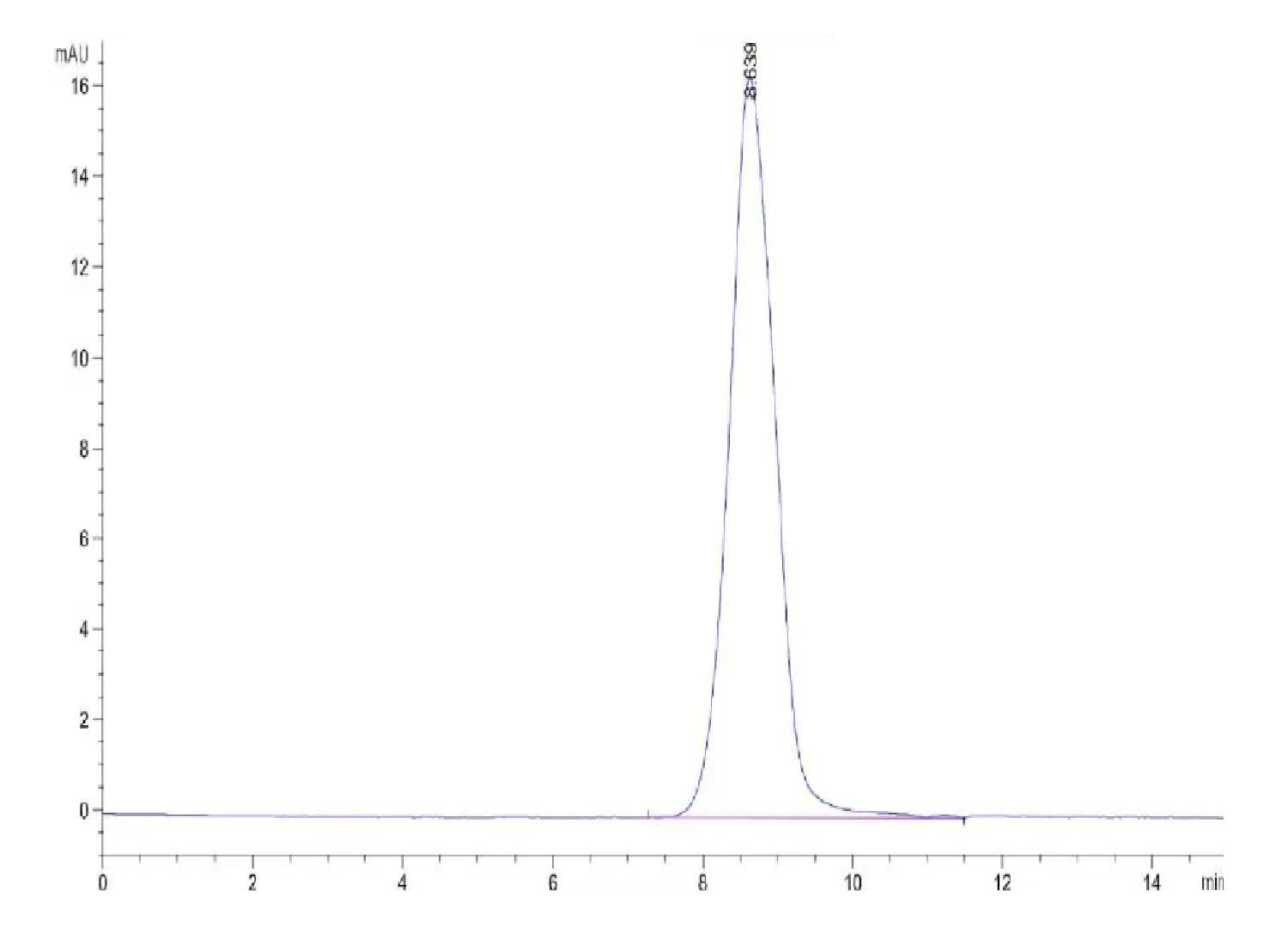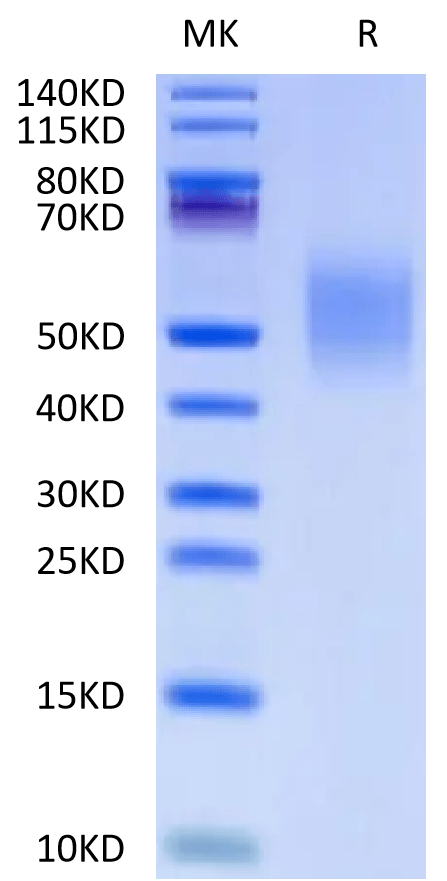| Weight | 1 lbs |
|---|---|
| Dimensions | 9 × 5 × 2 in |
| accession | P16070 |
| express system | HEK293 |
| product tag | C-His |
| purity | > 95% as determined by Tris-Bis PAGE;> 95% as determined by HPLC |
| background | CD44 is a hyaluronan binding cell surface signal transducing receptor that influences motility, cell survival and proliferation as well as the formation of tumor microenvironment. CD44 contains two variable regions encoded by variable exons. Alternative splicing, which is often deregulated in cancer, can produce various isoforms of CD44 with properties that may have different tissue specific effects and therefore even diverse effects on cancer progression |
| molecular weight | The protein has a predicted MW of 27.91 kDa. Due to glycosylation, the protein migrates to 45-68 kDa based on Tris-Bis PAGE result. |
| available size | 100 µg, 500 µg |
| endotoxin | Less than 1EU per μg by the LAL method. |
Human CD44 Protein 2607
$675.00
Summary
- Expression: HEK293
- Functional: Yes (ELISA)
- Amino Acid Range: Gln21-Pro220 & Gln386-Ala427
Human CD44 Protein 2607
| protein |
|---|
| Size and concentration 100, 500µg and lyophilized |
| Form Lyophilized |
| Storage Instructions Valid for 12 months from date of receipt when stored at -80°C. Recommend to aliquot the protein into smaller quantities for optimal storage. Please minimize freeze-thaw cycles. |
| Storage buffer Shipped at ambient temperature. |
| Purity > 95% as determined by Tris-Bis PAGE |
| target relevance |
|---|
| CD44 is a hyaluronan binding cell surface signal transducing receptor that influences motility, cell survival and proliferation as well as the formation of tumor microenvironment. CD44 contains two variable regions encoded by variable exons. Alternative splicing, which is often deregulated in cancer, can produce various isoforms of CD44 with properties that may have different tissue specific effects and therefore even diverse effects on cancer progression |
| Protein names CD44 antigen (CDw44) (Epican) (Extracellular matrix receptor III) (ECMR-III) (GP90 lymphocyte homing/adhesion receptor) (HUTCH-I) (Heparan sulfate proteoglycan) (Hermes antigen) (Hyaluronate receptor) (Phagocytic glycoprotein 1) (PGP-1) (Phagocytic glycoprotein I) (PGP-I) (CD antigen CD44) |
| Gene names CD44,CD44 LHR MDU2 MDU3 MIC4 |
| Mass 9606Da |
| Function Cell-surface receptor that plays a role in cell-cell interactions, cell adhesion and migration, helping them to sense and respond to changes in the tissue microenvironment (PubMed:16541107, PubMed:19703720, PubMed:22726066). Participates thereby in a wide variety of cellular functions including the activation, recirculation and homing of T-lymphocytes, hematopoiesis, inflammation and response to bacterial infection (PubMed:7528188). Engages, through its ectodomain, extracellular matrix components such as hyaluronan/HA, collagen, growth factors, cytokines or proteases and serves as a platform for signal transduction by assembling, via its cytoplasmic domain, protein complexes containing receptor kinases and membrane proteases (PubMed:18757307, PubMed:23589287). Such effectors include PKN2, the RhoGTPases RAC1 and RHOA, Rho-kinases and phospholipase C that coordinate signaling pathways promoting calcium mobilization and actin-mediated cytoskeleton reorganization essential for cell migration and adhesion (PubMed:15123640). |
| Catalytic activity #N/A |
| Subellular location Cell membrane ; Single-pass type I membrane protein. Cell projection, microvillus. Secreted. Note=Colocalizes with actin in membrane protrusions at wounding edges. Co-localizes with RDX, EZR and MSN in microvilli. Localizes to cholesterol-rich membrane-bound lipid raft domains. |
| Tissues Detected in fibroblasts and urine (at protein level) (PubMed:25326458, PubMed:36213313, PubMed:37453717). Detected in placenta (at protein level) (PubMed:32337544). Isoform 10 (epithelial isoform) is expressed by cells of epithelium and highly expressed by carcinomas. Expression is repressed in neuroblastoma cells. |
| Structure Interacts with PKN2 (PubMed:15123640). Interacts with TIAM1 and TIAM2 (By similarity). Interacts with HA, as well as other glycosaminoglycans, collagen, laminin, and fibronectin via its N-terminal segment (PubMed:14992719, PubMed:17085435, PubMed:25195884). Interacts with UNC119 (PubMed:19381274). Interacts with PDPN (via extracellular domain); this interaction is required for PDPN-mediated directional migration and regulation of lamellipodia extension/stabilization during cell spreading and migration (PubMed:20962267). Interacts with RDX, EZR and MSN (By similarity). Interacts with EGFR (PubMed:18757307, PubMed:23589287). Interacts with CD74; this complex is essential for the MIF-induced signaling cascade that results in B cell survival (By similarity). |
| Post-translational modification Proteolytically cleaved in the extracellular matrix by specific proteinases (possibly MMPs) in several cell lines and tumors.; N-glycosylated.; O-glycosylated; contains chondroitin sulfate glycans which can be more or less sulfated and whose number may affect the accessibility of specific proteinases to their cleavage site(s). It is uncertain if O-glycosylation occurs on Thr-637 or Thr-638.; Phosphorylated; activation of PKC results in the dephosphorylation of Ser-706 (constitutive phosphorylation site), and the phosphorylation of Ser-672. |
| Domain Th |
| Target Relevance information above includes information from UniProt accession: P16070 |
| The UniProt Consortium |
Data
Publications
Publications
| pmid | title | authors | citation |
|---|---|---|---|
| We haven't added any publications to our database yet. | |||
Protocols
| relevant to this product |
|---|
Documents
| # | ||
|---|---|---|
| Please enter your product and batch number here to retrieve product datasheet, SDS, and QC information. | ||

















